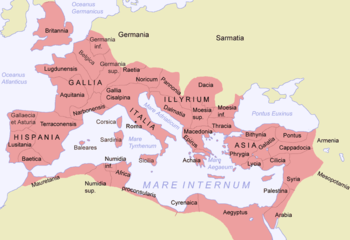Roman Times Quarterly
From NovaRoma
(Difference between revisions)
(content update) |
|||
| Line 17: | Line 17: | ||
{{sectionheaderrtq|In The Current Issue...}} | {{sectionheaderrtq|In The Current Issue...}} | ||
| − | * [[Roman Times Quarterly/QTR | + | * [[Roman Times Quarterly/QTR 1 2008|Roman Medicine]]: The tools of Roman Medicine which have come down to us through the efforts of archaeologists will give of some idea of the various techniques used for medical instances. [[Roman Times Quarterly/QTR 1 2008|More...]] |
---- | ---- | ||
| − | * [[Roman Times Quarterly/QTR | + | * [[Roman Times Quarterly/QTR 1 2008|Rome’s Pivotal Emperors: Augustus Caesar]]: In accepting his inheritance from Julius Caesar, Augustus turned the Republic into the empire. There was very little in the family origins of Augustus to indicate his future rise to prominence. [[Roman Times Quarterly/QTR 1 2008|More...]] |
---- | ---- | ||
| − | * [[Roman Times Quarterly/QTR | + | * [[Roman Times Quarterly/QTR 1 2008|Hannibal: Carthaginian General and Political Leader]]: Carthaginian general famed for bringing his army, including elephants over the Alps. He inflicted three huge defeats on Roman armies, including the largest ever at the Battle of Cannae in 216 BC. [[Roman Times Quarterly/QTR 1 2008|More...]] |
---- | ---- | ||
| − | * [[Roman Times Quarterly/QTR | + | * [[Roman Times Quarterly/QTR 1 2008|On Assignment: Augusta Treverorum (Trier)]]: The following is a report on Augusta Treverorum (Trier) on SEXTILIS XI-XIII MMDCCLIX (11-13 August 2759) by a member of Nova Roma currently living in Germania. [[Roman Times Quarterly/QTR 1 2008|More...]] |
---- | ---- | ||
| − | * [[Roman Times Quarterly/QTR | + | * [[Roman Times Quarterly/QTR 1 2008|On Ancient Geography]]: In ancient times the geography of the world was determined not only by actual surface exploration, but also by astronomy, philosophy, geometry, astrology and physics. [[Roman Times Quarterly/QTR 1 2008|More...]] |
---- | ---- | ||
| − | * [[Roman Times Quarterly/QTR | + | * [[Roman Times Quarterly/QTR 1 2008|Mines and Quarries: Laurium]]: One of the best known mining regions of the classical world was southeastern Attica, especially in the area of Mount Laurium (Laurion). It is here that there are the remains of an ancient Mycenean citadel at Velatouri. [[Roman Times Quarterly/QTR 1 2008|More...]] |
Revision as of 14:00, 4 April 2008
|
Welcome to the Roman Times Quarterly Webzine!
Roman Times Quarterly is a publication providing insight on the very best of ancient Roman life.
| ||
|
In The Current Issue...
|
|
From the Editor's Desk Have an interesting aricle or series you would like to share with others on ancient Rome? Send us your works for preview for inclusion in the next issue of the RTQ today! Inquiries and contributions for publication consideration may be sent to this webzine via the Editor at: jmath669642reng@webtv.net Senior Editor: Senator Marcus Audens
Past Issues
Also, visit our RTQ blog at: http://romantimesquarterly.blogspot.com
|

